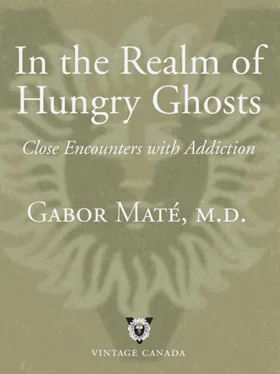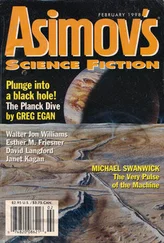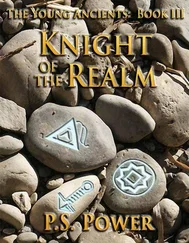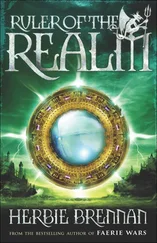There is an area in the midbrain which, when triggered, gives rise to intense feelings of elation or desire. It’s called the ventral tegmental apparatus, or VTA. When researchers insert electrodes into the VTA of lab rats and the animals are given a lever that allows them to stimulate this brain centre, they’ll do so to the point of exhaustion. They ignore food and pain just so they can reach the lever. Human beings may also endanger themselves in order to continue self-triggering this brain area. One human subject stimulated himself fifteen hundred times in a three-hour period, “to a point that he was experiencing an almost overwhelming euphoria and elation, and had to be disconnected despite his vigorous protests.” 1
Dopamine is the neurotransmitter chiefly responsible for the power of the VTA and its associated network of brain circuits. Nerve fibres from the VTA trigger dopamine release in a brain centre that plays a central role in all addictions: the nucleus accumbens, or NA, located on the underside of the front of the brain. Sudden increases in dopamine levels in the nucleus accumbens set off the initial excitement and elation experienced by drug users, and this is also what rats and people are after when they keep pushing those levers. All abusable substances raise dopamine in the NA, stimulants like cocaine most dramatically.

As in the case of the opioid apparatus, Nature did not design the VTA, the NA or other parts of the brain’s dopamine system just so the addicts and drug users of the world could feel happier or more energized and focused. Indeed, the human brain’s dopamine circuits are no less important to survival than its opioid system. If opioids help consummate our reward-seeking activities by giving us pleasure, dopamine initiates these activities in the first place. It also plays a major role in the learning of new behaviours and their incorporation into our lives.
Along with its connections in the forebrain and the cortex, the VTA thus forms the neurological basis of another major brain system involved in the addiction process: the incentive-motivation apparatus. This system responds to reinforcement, and reinforcers all have the effect of increasing dopamine levels in the nucleus accumbens.
Let’s take a hypothetical situation involving a hypothetical “you.” You see a chocolate bar in a Hallowe’en bag, and you’re seized by a desire to munch on it: a classic example of a positively reinforced behaviour. That is, you’ve tasted a similar chocolate bar before and liked the experience. Now, when this new bar appears in your sight, dopamine is released in the NA, inciting you to take a bite. Your four-year-old daughter, to whom the bar belonged, accuses you of thieving. “The dopamine made me do it,” you say in self-defence. Your daughter, nothing if not a reasonable preschooler, drops her resentment. “Of course, Daddy,” she says sweetly, “because a cue associated with a previously pleasurable experience triggers a surge of dopamine in the NA and incites consummatory behaviour. Seeing my candy bar was your cue, and eating it was the consummatory behaviour. You have such a silly, predictable reinforcement system.” “Wow,” you say. “That’s exactly right, honey. Will you share that last piece of chocolate with me?” “No way! Your dopamine circuits aren’t my problem.”
Environmental cues associated with drug use—paraphernalia, people, places and situations—are all powerful triggers for repeated use and for relapse, because they themselves trigger dopamine release. People trying to quit smoking, for example, are advised to avoid poker if they are used to having a cigarette while playing cards. Unless they move to a different area of town or to a recovery home, my Downtown Eastside patients find it virtually impossible to stop drug use, even when they form a strong intention to do so. Not only are drugs readily available, but everything and everyone in the environment reminds them of their habit.
Reinforcement is important in all addictions, drug-related or not. In my own case, it doesn’t help matters that the Portland Hotel is located within a few blocks of those unscrupulous compact disc pushers at Sikora’s, my favourite music haunt, and that I drive by there most days on my way to or from work. As I described earlier, I can feel excitement rising as I approach the store, even when I have no plan to go there, along with an urge to park the car and walk in. In my nucleus accumbens, the dopamine is flowing. The incentive is powerful.
Needless to say, life-essential reinforcers such as food and sex trigger VTA activation and dopamine release in the NA, since the performance of survival-related behaviours is the very purpose of the incentive-motivation system. Accordingly, this system is decisive in initiating activities such as foraging for food and other life-sustaining necessities, seeking sexual partners and exploring the environment. The VTA and NA and their connections with other brain circuits are also active when we explore novel objects and situations and evaluate them in light of previous reinforcing experiences. In other words, nerve fibres in the VTA are triggering dopamine release in the NA when a person needs to know, “Is this new whatever-it-is going to help me or hurt me? Will I like it or not?” The role of the dopamine system in novelty-seeking helps explain why some people are driven to risky behaviours such as street racing. It’s one way to experience the excitement of dopamine release.
Dopamine activity also accounts for a curious fact reported by many drug addicts: that obtaining and preparing the substance gives them a rush, quite apart from the pharmaceutical effects that follow drug injection. “When I draw up the syringe, wrap the tie and clean my arm, it’s like I’m already feeling a hit,” Celia, the pregnant woman described in Chapter 6, once told me. Many addicts confess that they’re as afraid of giving up the activities around drug use as they are of giving up the drugs themselves.

It is fascinating to look at some of the evidence linking the dopamine system to addictions. Animal experiments, distressing as they sometimes are to read about, can be stunning for their scientific ingenuity and technical expertise. Just how important dopamine receptors are to substance use was illustrated by a study of mice who had previously been trained to drink alcohol. They were given an “infusion” of dopamine receptors right into the nucleus accumbens. Before the infusion these rodents had fewer than normal dopamine receptors. The receptors were incorporated into a harmless virus that entered the animals’ brain cells so that, temporarily, a normal range of receptor activity was achieved. As long as this artificial supply of dopamine receptors was available, the mice reduced their alcohol intake considerably—but they gradually became boozers again as the implanted receptors were lost to natural attrition. 2
Why is this relevant? First, as I’ve already explained, chronic cocaine use reduces the number of dopamine receptors and thereby keeps driving the addict to use the drug simply to make up for the loss of dopamine activity. No wonder Lisa ended up with syphilis contracted in a back alley encounter. That was her way of obtaining the substance the incentive circuits in her brain were screaming for. (If she’d only had a nicotine addiction, she could have purchased a drug supplied by respectable manufacturers and dealers.) Dopamine receptor availability is also reduced in alcoholics, as well as in heroin and crystal meth addicts. 3
More importantly, research now strongly suggests that the existence of relatively few dopamine receptors to begin with may be one of the biological bases of addictive behaviours. 4When our natural incentive-motivation system is impaired, addiction is one of the likely consequences. But why would some creatures—human or non-human—have relatively few dopamine receptors? Why, in other words, would their natural incentive system be underfunctioning? I will soon present the evidence to show that such lacks are not random occurrences but have predictable—and preventable—causes.
Читать дальше













